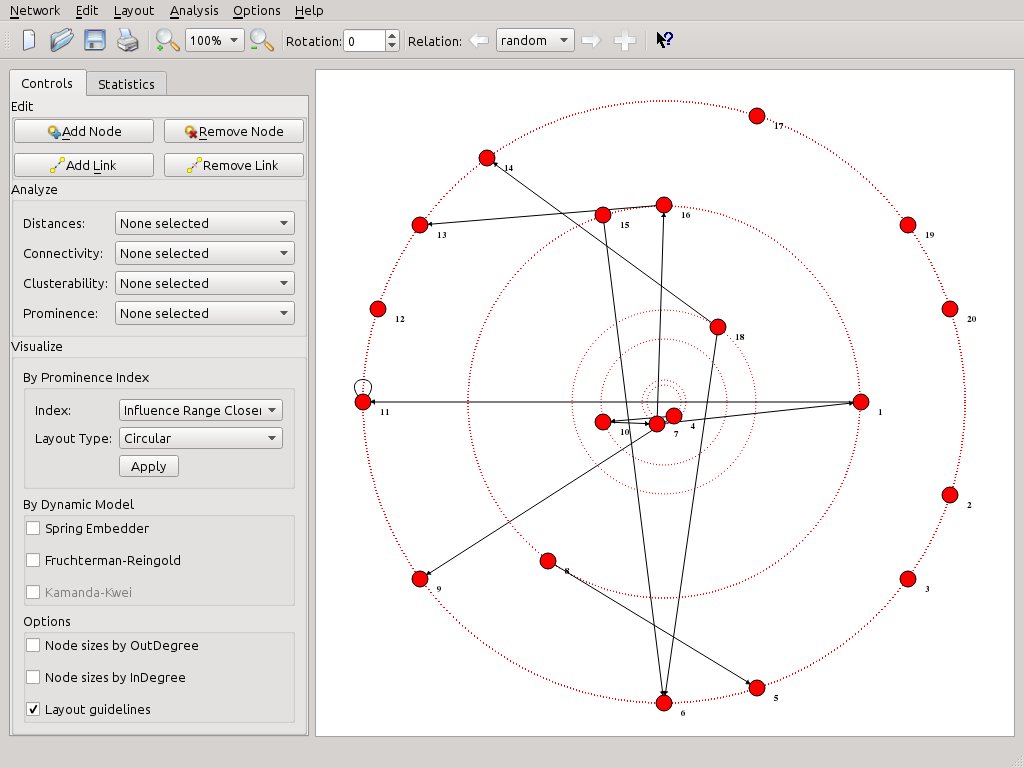I am happy to announce a new major release of Social Network Visualizer (SocNetV), the Social Network Analysis software. SocNetV v2.0 comes with a major code overhaul for stability and performance boost, improved GUI with a new panels layout, and nice new features for easier social network analysis, such as separate modes for graphs and digraphs, permanent settings/preferences functionality, edge labeling, recent files, keyboard shortcuts, etc. Also there are improvements in Force-Directed layouts, i.e. Fructherman-Reingold. The new version supports Windows, Linux and Mac OS X. Binary installers and source code packages are available from the project’s Download page. See below a walk-through of the new features.
Tag: Social Networks Page 1 of 2
When I started developing SocNetV back in 2005 the term “social network” had a simple sociological meaning; any group of somehow “connected” actors, which might interest a sociologist to study and analyse in terms of their social properties and patterns (centralities, triads, etc). The actors can be of any type (humans, animals, organisations, companies etc) and so the cause of them being connected: working in the same place, belong to the same hive/group, mentioning each other, having commercial relations etc. Thus the main reason behind developing SocNetV was to create a simple “point and click” application that would enable the researcher to load his real-life gathered data and visualize/analyze the network properties. Or, in case the network was small enough, perhaps recreate it with some clicks on a canvas before analysing it. Back then it had never occurred to me that the same “social network” would be used now-days to describe online communities of million of users. As a matter of fact, I always thought that this strand of sociology is more meaningful in analysing relatively small groups rather than thousands of interconnected actors. Nevertheless, the term is used now this way too and this means that Social Network Analysis software such as SocNetV face a new problem: people not knowing anything about Social Network Analysis as a hybrid sociology-mathematics discipline think that all the software does is to “automatically” analyse any given online virtual community; who is connected to whom and how. Which is certainly not true.
Over the last weeks, the Social Networks Visualizer (SocNetV) project has released two new versions which brought useful new features and of course a lot of bugfixes. The latest v1.4 closed even 4 years old bugs!
The strongest new feature of SocNetV is multirelational editing. You can now load or create a social network on the canvas, for instance depicting the friendship ties between kids in a classroom, and then add a new relation (Cltr+Shift+N) which it might depict i.e. “likes” between pairs of the same clasroom kids. And you can be do this very easily as we will demonstrate in this article.
A new version of SocNetV, the cross-platform tool for social network analysis and visualization, has been released. Version 1.2 brings a major GUI overhaul, a new conceptualization of “prominence” measures, new importance and reachability measures, many new visualization layouts based on the new indices, and fixes a slew of bugs (see below).
If you’re interested in Social Networks Analysis and Visualization (I’m not talking about FB/Twitter here!), check out our latest and greatest release of SocNetV, version 1.0.
SocNetV (Social Networks Visualizer) is now based on Qt5/C++ framework and has new great features, such as PageRank network analysis and, of course, layouts. At the moment, there is only source code and Fedora/openSUSE packages available from our project page in SourceForge. Soon, Debian/Ubuntu packages will be released as well. Warning: There are SocNetV packages in the official Debian/Ubuntu repositories, but it’s a very old version. Maybe a brave debian developer (serzan?) could fix this soon 🙂
Needless to say: SocNetV is a GPL3 application. It is free software (free as in freedom). You can copy it, modify it and redistribute it as long as any derivative work remains free software. Enjoy.
Easy. Short of.
I did this ‘experiment’ to test how much cross-platform Qt really is. I wanted to see if SocNetV can run on Maemo with no modifications whatsoever. These are the steps I followed:
1. Downloaded and installed the Xephyr X11 server (this is a small X11 server that runs inside ‘normal’ X and provides a virtual device screen where you see all the Maemo applications running):
sudo apt-get install xserver-xephyr |
2. Downloaded and installed Scratchbox and Maemo SDK in my laptop (Kubuntu x86/lucid). I followed the straightforward instructions from the Maemo wiki and especially “Installing Maemo 5 SDK on x86-32 Debian based distribution“. It’s only seven steps and circa 100MBs of total downloads…
Last Friday, it was high time to release a new SocNetV version. The brand new v0.80, the first after six months, marked what I think the start of a more mature period for this tiny little project of mine.
What started as a personal desire to create a simple drawing tool for social networks has become a quite sophisticated tool for social network analysis (spare me, I am talking about mathematical sociology here, not facebook etc):
- It can read all major network file formats (GraphML, pajek, GraphViz, UCINET, csv, or adjacency matrix) and save the network in GraphML. In the next version, I plan to even add support for the older GML format.
- It can swiftly compute centrality measures (closeness, betweeness, eccentricity, etc) and layout the network actors accordingly, in radial or layered style, at least for small to medium sized networks (i.e. < 3000 edges). Moreover, it implements one of the fastest known betweeness centrality calculation algorithms. For the 0.90 release, I want to add a couple or more new centrality algorithms (i.e. power centrality by Gil-Mendieta and Schmid).
- Since 0.70, it can even crawl a given website and create the network of its outLinks. Later, I plan to add support for mailing list archives crawling…
In the new version, I added some social capital features. The software can compute a ‘triad census’, namely it counts all the different types (classes) of observed triads within a network. The triad types are coded and labeled according to their number of mutual, asymmetric and non-existent (null) dyads (this labeling scheme is called M-A-N). This new feature is complimented by a simple, naive (please note, this is a NP-complete problem) clique counting alrorithm.
Also, the speed of the network parser has been improved somewhat by removing some unnecessary checks and adding a simple control variable. And the GraphViz load method is a lot better now. I think. 🙂
As usual, at least a dozen of bugs have been reported and fixed. Of course, it’s not perfect, and certainly many improvements can be made, but the code is there, and is constantly evolving. I think that it deserves to be named 0.80. I am not sure though how easy will be to reach the other 0.20 to the first 1.0 release… If you have an idea about a possible feature, feel free to submit a blueprint.
As usual, source code and binaries for all major distros are available from the project website at SourceForge.






